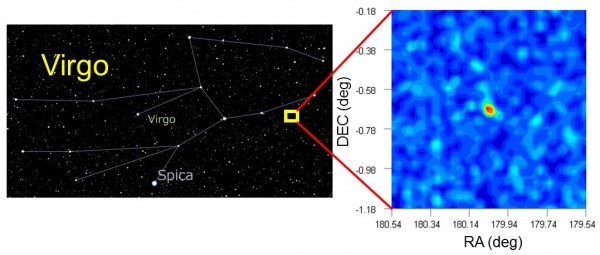By Ana Verayo, | November 22, 2016

The position of Virgo I in the constellation of Virgo (left). (Tohoku University/National Astronomical Observation of Japan)
Astronomers have detected the faintest dwarf galaxy located in the core of the Milky Way galaxy. This galaxy is located in the constellation Virgo, and scientists have named it Virgo I.
A team from Tohoku University in Japan detected this faint galaxy during the ongoing Subaru Strategic Survey using a massive digital still camera known as Hyper Suprime-Cam. This study suggests that there is a significant population of faint dwarf galaxies in the halo of the Milky Way.
Like Us on Facebook
Dwarf galaxies have been an enigma for astronomers for a long time. There are potentially hundreds of dwarf galaxies which orbit the Milky Way. However, astronomers have only detected 50 small galaxies within 1.4 million light-years in the Milky Way.
Scientists describe these known dwarf galaxies as dwarf spheroidal galaxies that currently orbit the Milky Way galaxy, very much similar to how moons orbit Saturn, but in the form of galaxies orbiting a large galaxy.
In this new study, these recently discovered dwarf galaxies are so faint that they are called ultra-faint dwarf galaxies. The fainter the galaxy, the much difficult it is to detect, which suggests that more dwarf galaxies do exist, but they have not yet been seen.
The detection of Virgo I is considered a scientific breakthrough since this means that there is new technology that can detect very faint galaxies that orbit our Milky Way including dwarf galaxies.
Scientists suggest that there are hundreds of faint dwarf galaxy satellites lurking around the halo of the Milky Way. Further research can reveal not only how many satellite galaxies are revolving around the Milky Way, but also provide crucial clues about the evolution of our home galaxy and how dark matter shaped the Milky Way.
This new study was published in the Astrophysical Journal.
-
Use of Coronavirus Pandemic Drones Raises Privacy Concerns: Drones Spread Fear, Local Officials Say

-
Coronavirus Hampers The Delivery Of Lockheed Martin F-35 Stealth Fighters For 2020

-
Instagram Speeds Up Plans to Add Account Memorialization Feature Due to COVID-19 Deaths

-
NASA: Perseverance Plans to Bring 'Mars Rock' to Earth in 2031

-
600 Dead And 3,000 In The Hospital as Iranians Believed Drinking High-Concentrations of Alcohol Can Cure The Coronavirus

-
600 Dead And 3,000 In The Hospital as Iranians Believed Drinking High-Concentrations of Alcohol Can Cure The Coronavirus

-
COVID-19: Doctors, Nurses Use Virtual Reality to Learn New Skills in Treating Coronavirus Patients







